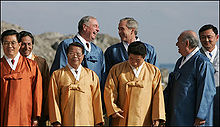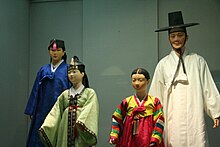 Various world leaders wearing durumagi in 2005 Various world leaders wearing durumagi in 2005 | |
| Type | Po (Overcoat), Hanbok |
|---|---|
| Material | Various |
| Place of origin | Korea |
| Durumagi | |
| Hangul | 두루마기 |
|---|---|
| Revised Romanization | Durumagi / |
| McCune–Reischauer | Turumagi / |
| Other names | |
| Hangul | 주막의· 주차의· 주의 |
| Hanja | 周莫衣· 周遮衣· 周衣 |
| Revised Romanization | Jumagui / Juchaui / Juui |
| McCune–Reischauer | Chumagi / Chuch'ai / Chui |
Durumagi (Korean: 두루마기; lit. closed all around) is a variety of po, or overcoat, in hanbok, the traditional Korean attire. It is a form of outerwear which is usually worn as the topmost layer of clothing, over a jeogori (jacket) and baji (pants). It also goes by the names jumagui (주막의; 周莫衣), juchaui (주차의; 周遮衣), or juui (주의; 周衣),
History
The origin of durumagi traces back to at least the Three Kingdoms of Korea, where it originated from a long coat worn by the northern Chinese to fend off cold weather in ancient times. This form of paofu (Chinese robes) was mid-calf in length and had binding which were similar to those used in the jeogori. Such form of robes looked similar to the zhiju (Chinese: 直裾) which was developed since Shang dynasty. Two unearthed examples of the zhiju can be found in Mawangdui (马王堆) BC 206–24 and Mashan chumu (马山楚墓) BC 770–476.
Tomb murals from Goguryeo were primarily painted in two regions, Ji'an (集安) and Pyeongyang, which are the second and third capitals of the Goguryeo from the middle of the 4th to the middle of the 7th centuries respectively. The paintings datings from this period in the region of Jian typically shows the characteristics of the people of Goguryeo in terms of morals and customs while those in the regions of Pyeongyang would typically show the cultural influence of the Han dynasty, including figures dressed in Chinese-style attire, as the Han dynasty had governed this geographical region for approximately 400 years.
According to Samuel Lee, the origins of the durumagi can be traced back to the Goguryeo period:
" Murals also show that both men and women wore chima. The type worn by both for formal occasions was sang and that worn only by women was goon, which had long and wide dimensions. The origin of durumagi, the long outer coat worn over a jeogori, goes back to the Goguryeo period. The durumagi emanates form the long coat worn by northern Chinese to fend off cold weather in ancient times. The long coat reached mid-calf and had bindings similar to those used for jeogori. Later, this was adopted by the Goguryeo upper class in various forms for ceremonies and rituals, and the modified form worn by the general populace came to be known as durumagi.
However, what is now known as the durumagi is part of the indigenous attire of the Korean people:
한국 민족의 고유복식은 저고리와 바지, 두루마기로 돼 있다. 이런 복식은 북방 호복(胡服)계열로 바지를 착용했다는 것은 기마민족(騎馬民族)이었음을 의미한다는 것이다.The traditional clothing of the Korean people consists of a jeogori, baji, and a durumagi. This kind of attire is related to the northern hobok, and wearing pants means that they were a horse-riding people.Based on the Goguryeo mural paintings found near Pyeongyang, such as the early 5th century murals from Gamsinchong (龕神塚), the ancient durumagi worn by the owner of Gamsinchong tomb was red (or purple) in colour:
is sitting on a flat bench under a red curtain, in a purple durumagi (a traditional Korean men’s overcoat) with both hands held inside the wide sleeves on his chest. He wears a dark silk hat that shows his high societal position.
The Gamsinchong murals show a mixture of elements from before and after the fifth century; the wide-sleeves attire also reflect the characteristics of tomb murals which are found near the Pyeongyang area. The ancient durumagi was also worn with a waist belt and had wide sleeves.
Goryeo
During the Goryeo period, Mongolian influences caused the durumagi to change in appearance. Not only was the waist belt changed into a goreum, the traditional po's short length and wide sleeves were lengthened and narrowed to the style of the Mongolian coat, xurumakci, of which the name durumagi is said to be derived.
Joseon period
During the Joseon dynasty, the durumagi was less worn as an overcoat but more of a housecoat for the noble class, whereas it was worn outdoors by the commoners. In 1884, King Gojong promulgated the unification of clothing for all social classes through reform laws. However, this law was met with much resistance and it was only until ten years later, after the Gabo Reform of 1894, that the durumagi became common as formal attire.
Construction and design
The durumagi is an overcoat, which is closed all around, lacking side and back vents. It has a straight collar with front overlapping front panels closing to the right, side gores, chest ties, neckband and narrow sleeves; its length is about under the calves and above the ankles.
Different fabrics and materials are used in making durumagi: calico, wool, cotton, and various silks for winter; ramie, fine ramie and silk gauze for summer; various silks and calico for spring and autumn. White, grey and navy blue are commonly used.
Types of durumagi

There are various types which include the hotedan durumagi (홑단 두루마기; lit. single-layer durumagi), gyup durumagi (겹 두루마기; lit. double-layer durumagi), som durumagi (솜 두루마기; lit. cotton durumagi), kkachi durumagi (까치 두루마기; lit. magpie durumagi), and obangjang durumagi (오방장 두루마기; lit. five-colour durumagi) for children.
Modern use

The durumagi is still considered an important part of traditional attire for formal occasions, but a variety of colours and designs are being used. Colourful durumagi were given as gifts to the world leaders of the 2005 APEC Summit in Busan.
See also
References
- ^ Encyclopedia of Traditional Korean clothing. Vol. VI (English ed.). Seoul: National Folk Museum of Korea. 2021. ISBN 9788928902873.
- ^ "두루마기" [Durumagi]. Doosan Encyclopedia (in Korean). Archived from the original on 21 March 2022. Retrieved 21 March 2022.
- ^ Lee, Samuel Songhoon (2013). Hanbok: Timeless Fashion Tradition. Seoul Selection. pp. 13–14. ISBN 9781624120565. Retrieved 2 February 2021.
- Wang, Bo (961). 唐会要 新罗 TangHuiYao – Silla. Retrieved 6 February 2021.
- Wei, Shou (551–554). 魏书 百济 Book of Wei – Baekje. Retrieved 6 February 2021.
- Wang, Qinruo (1013). 冊府元龜 Cefu Yuangui-chapter 936&975. Retrieved 5 February 2021.
- "3.3.1 直裾长衣". Hunan Provincial Museum. Retrieved 5 February 2021.
- 长沙马王堆一号汉墓发掘简报. Institute of Archaeology, Chinese Academy of Social Sciences. 1 July 1972. Retrieved 5 February 2021.
- ^ National Museum of Korea Editorial Team (Spring 2009). "National Museum of Korea Vol.07". Quarterly Magazine. Vol. 7, no. 7. Retrieved 26 June 2022.
Goguryeo tomb murals were primarily painted in Jian 集安 and Pyeongyang,平壤 the second and third capitals of the kingdom from the middle of the fourth century until the middle of the seventh, respectively. They also display slightly different characteristics by region. For example, the morals and customs of Goguryeo are featured in murals found in Jian, while those in Pyeongyang show the cultural influence of the Han dynasty 202 BC-AD 220 in China, which governed the region for about four hundred years. This explains why we can see figures in Chinese-style dress in the latter.
- "두루마기". The Korea Times. Retrieved 10 July 2022.
- ^ National Museum of Korea Editorial Team (Spring 2009). "National Museum of Korea Vol.07". Quarterly Magazine. Vol. 7, no. 7. Retrieved 26 June 2022.
- ^ "'두루마기' - 네이트 백과사전" ['Durumagi' - Nate Encyclopedia]. Nate. Archived from the original on 10 June 2011. Retrieved 20 June 2023.
- Lee, Yi Hwa (1999). 한국사 이야기 7 – 몽골의 침략과 30년 항쟁 [Korean History 7 – Mongol Invasion and 30 Years' Rebellion] (in Korean). Paju: Hangilsa. p. 58. ISBN 89-356-5146-X.
- "갑신의복개혁령" [Gapsin Clothing Reform Decree]. Doosan Encyclopedia (in Korean). Retrieved 20 June 2023 – via Naver.
- (in Korean) New hanbok, Herald Biz 2010-03-30. Retrieved 14 June 2010
- (in Korean) Obangjang durumagi from Daum Communications and Korea Culture & Content Agency
- (in Korean) Durumagi a must, bnt news 14 February 2010
- (in Korean) Leaders in durumagi, Nocut News 25 November 2005
- Lee Ho-jeong (7 May 2007). "Clothing with stories of fertility and faith". JoongAng Daily.
External links
- Owner of Gamsinchong tomb wearing a purple (or red) durumagi from the National Museum of Korea
- Korea National Heritage online from the Cultural Heritage Administration
- (in Korean) Hanbok Story